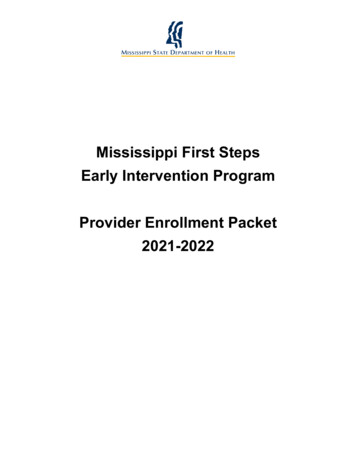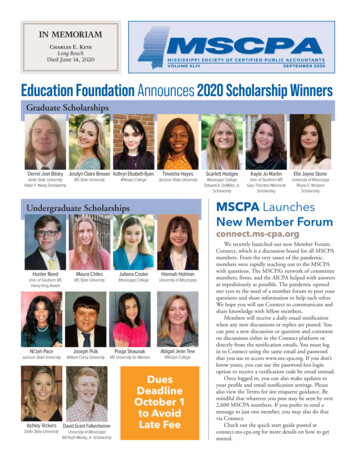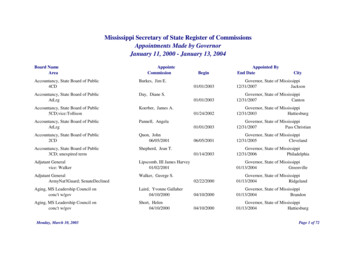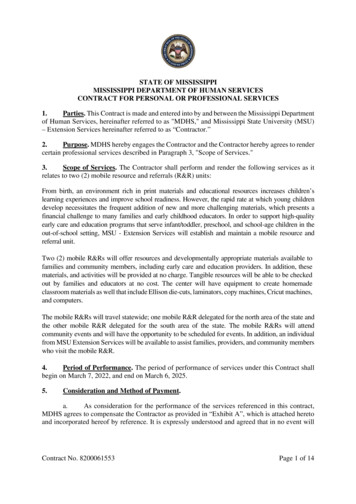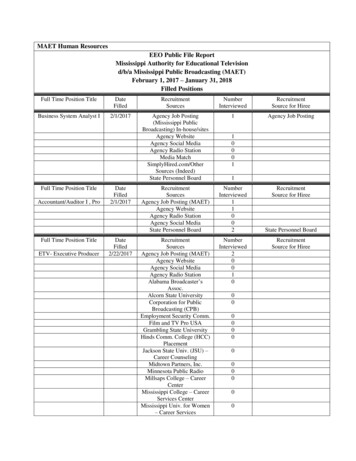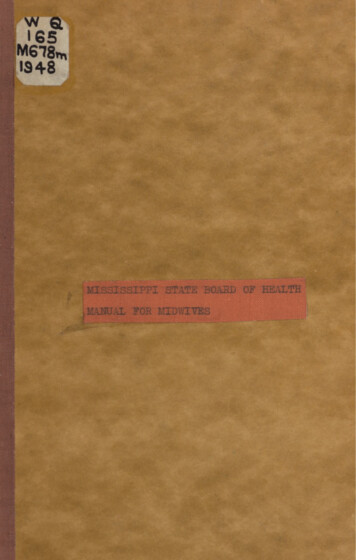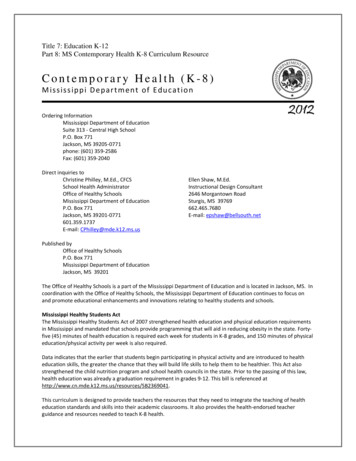
Transcription
Title 7: Education K-12Part 8: MS Contemporary Health K-8 Curriculum ResourceContemporary Health (K-8)M i s s i s s i p p i D e pa r t m e nt o f E du c a t i o nOrdering InformationMississippi Department of EducationSuite 313 - Central High SchoolP.O. Box 771Jackson, MS 39205-0771phone: (601) 359-2586Fax: (601) 359-2040Direct inquiries toChristine Philley, M.Ed., CFCSSchool Health AdministratorOffice of Healthy SchoolsMississippi Department of EducationP.O. Box 771Jackson, MS 39201-0771601.359.1737E-mail: CPhilley@mde.k12.ms.usEllen Shaw, M.Ed.Instructional Design Consultant2646 Morgantown RoadSturgis, MS 39769662.465.7680E-mail: epshaw@bellsouth.netPublished byOffice of Healthy SchoolsP.O. Box 771Mississippi Department of EducationJackson, MS 39201The Office of Healthy Schools is a part of the Mississippi Department of Education and is located in Jackson, MS. Incoordination with the Office of Healthy Schools, the Mississippi Department of Education continues to focus onand promote educational enhancements and innovations relating to healthy students and schools.Mississippi Healthy Students ActThe Mississippi Healthy Students Act of 2007 strengthened health education and physical education requirementsin Mississippi and mandated that schools provide programming that will aid in reducing obesity in the state. Fortyfive (45) minutes of health education is required each week for students in K-8 grades, and 150 minutes of physicaleducation/physical activity per week is also required.Data indicates that the earlier that students begin participating in physical activity and are introduced to healtheducation skills, the greater the chance that they will build life skills to help them to be healthier. This Act alsostrengthened the child nutrition program and school health councils in the state. Prior to the passing of this law,health education was already a graduation requirement in grades 9-12. This bill is referenced This curriculum is designed to provide teachers the resources that they need to integrate the teaching of healtheducation standards and skills into their academic classrooms. It also provides the health-endorsed teacherguidance and resources needed to teach K-8 health.
Table of ContentsAcknowledgments. 3Standards . 4Preface. 5Contemporary Health (K-8) Executive Summary . 6Contemporary Health - First Grade . 21Contemporary Health - Second Grade . 33Contemporary Health - Third Grade . 45Contemporary Health - Fourth Grade . 56Contemporary Health - Fifth Grade . 67Contemporary Health - Sixth Grade . 77Contemporary Health - Seventh Grade . 87Contemporary Health - Eighth Grade . 98Student Competency Profile - Kindergarten . 109Student Competency Profile - First Grade . 110Student Competency Profile – Second Grade . 111Student Competency Profile – Third Grade. 112Student Competency Profile – Fourth Grade . 113Student Competency Profile – Fifth Grade . 114Student Competency Profile – Sixth Grade . 115Student Competency Profile – Seventh Grade. 116Student Competency Profile – Eighth Grade . 117Appendix A: Activities and Rubrics . 118Appendix B: Industry Standards . 160Appendix C: Common Core Standards. 162Appendix D: Mississippi House Bill 999 . 166Appendix E: Mississippi Senate Bill 2472 – Nathan’s Law . 173Mississippi Contemporary Health (K-8) Curriculum ResourcePage 2 of 181
AcknowledgmentsThe Contemporary Health (K-8) curriculum was presented to the Mississippi Board of Education on November 15,2012. The following persons were serving on the state board at the time:Dr. Lynn House, Interim State SuperintendentDr. O. Wayne Gann, ChairMr. Howell “Hal” N. Gage, Vice ChairMs. Kami BumgarnerMr. William Harold JonesDr. John R. KellyMr. Charles McClellandMr. Richard MorrisonMs. Martha “Jackie” MurphyMr. Simon F. Weir, IIScott Clements, Bureau Director for the Office of Healthy Schools, provided guidance as the taskforce committeewas assembled and provided input throughout the development of the Contemporary Health (K-8). Members ofthis taskforce were as follows:Janet Hankins, Retired, Clinton Public School District, Clinton, MSBetty Kennedy, Byram Middle School, Hinds County School District, Terry, MSPam Piazza, Byram Middle School, Hinds County School District, Terry, MSDixie Pogue, District Health Coordinator, South Panola School District, Batesville, MSKay Strickland, Corinth Elementary School, Corinth School District, Corinth, MSAppreciation is expressed to the following professionals who provided guidance and insight throughout thedevelopment process:Christine Philley, M.Ed., CFCS, School Health Administrator, Office of Healthy Schools, MississippiDepartment of Education, Jackson, MSEstelle Watts, MSN, NCSN, State School Health Consultant, Office of Healthy Schools, MississippiDepartment of Education, Jackson, MSMississippi Contemporary Health (K-8) Curriculum ResourcePage 3 of 181
StandardsStandards in the Contemporary Health (K-8) Curriculum Framework and Supporting Materials are based on thefollowing:National Health Education StandardsThe National Health Education Standards were developed by a joint committee consisting of the AmericanAssociation for Health Education, American Public Health Association, American School HealthAssociation, and the Society of State Leaders of Health and Physical Education. The standards arepublished by the Centers for Disease Control and Prevention, are meant for public use, and are notsubject to copyright law protections. Permission is not required for use of public domain items.Reprinted from ex.htm.Common Core State Standards InitiativeThe Common Core State Standards provide a consistent, clear understanding of what students areexpected to learn, so teachers and parents know what they need to do to help them. The standards aredesigned to be robust and relevant to the real world, reflecting the knowledge and skills that our youngpeople need for success in college and careers. With American students fully prepared for the future, ourcommunities will be best positioned to compete successfully in the global economy. Copyright 2010.National Governors Association Center for Best Practices and Council of Chief State School Officers. Allrights reserved. States and territories of the United States as well as the District of Columbia that haveadopted the Common Core State Standards in whole are exempt from this provision and no attributionto the National Governors Association Center for Best Practices and Council of Chief State SchoolOfficers is required. Reprinted from http://www.corestandards.org/.National standards are superscripted in each unit and are referenced in Appendix B. Common Core Statestandards are referenced in Appendix C.Mississippi Contemporary Health (K-8) Curriculum ResourcePage 4 of 181
PrefaceAs with all disciplines, Contemporary Health (K-8) must include a range of educational experiences. It should betaught in a way that students can obtain, interpret, and apply basic health information to their daily lives toenhance their individual health. In order to be health literate, students must be encouraged to be self-directedlearners while establishing a basic understanding of health promotion and disease prevention. They should beencouraged to use literacy, numerical skills, and critical thinking skills to gather, analyze, and apply healthinformation as their needs and priorities change throughout life. They must also use interpersonal and social skillsin relationships to learn about others and from others.The interdisciplinary nature of health contributes to the feasibility of infusing health content and skills acrossdisciplines. These standards provide a way of making the school program more responsive to student, family, andcommunity needs.The 2012 Mississippi Contemporary Health (K-8) Framework serves as a guide for teachers to provide acomprehensive learning experience for students. This course should include all dimensions of health, including, butnot limited to, community/environmental health, consumer health, disease prevention and control, human growthand development, nutrition, family life, safety and first aid, personal health, mental health, and drug abuseprevention. The students should also gain an understanding about the importance of participation in physicalactivity.The courses in this document reflect the statutory requirements as found in Section 37-3-49, Mississippi Code of1972, as amended (Section 37-3-46); Section 37-13-134, Mississippi Code of 2011; House Bill 999, Section 37-13171, Mississippi Code of 1972, as amended (Section 37-13-171 and 37-13-173); and Nathan’s Law Section 63-3615, Mississippi Code of 1972, as amended (Sections 63-1-73, 97-3-7, and 63-1-33) . In addition, this curriculumreflects guidelines imposed by federal and state mandates (Laws, 2002, ch. 585, § 2; Laws, 2003, ch. 436, § 1; Laws,2006, ch. 401, § 1; Laws, 2007, ch. 521, § 2, eff from and after July 1, 2007; and No Child Left Behind Act of 2001).Mississippi Contemporary Health (K-8) Curriculum ResourcePage 5 of 181
Contemporary Health (K-8) Executive SummaryPHILOSOPHYLearning is an active process and individuals learn best from instruction that is hands-on and related to lifeexperiences. All students should have the opportunity to learn. However, the capacity for success is diminished ifstudents are absent or distracted by unhealthy behaviors or hazardous situations. Health Education must be acollaborative process between family, school, and community. Health-literate students should have the capacity toobtain, interpret, and use basic health information and skills to enhance individual health. Health instructionfocuses on the health and wellness of students and must become an integral and consistent part of the totalschool program. Instruction that begins while children are young and continues through youth reinforces thepositive behaviors to be sustained throughout adulthood.MISSION STATEMENTThe 2012 Mississippi Contemporary Health (K-8) Framework ensures that all students gain information to developpositive attitudes, behaviors, and skills necessary to make health-enhancing decisions that are age anddevelopmentally appropriate with the ability to apply skills responsibly for a lifetime.PURPOSEThe 2012 Mississippi Contemporary Health (K-8) Framework promotes the development of health skills needed toimprove quality of life. Based on the National Health Education Standards, the framework emphasizes the holisticdimensions of health education. It enables students to become health literate, self-directed learners, whichestablishes foundations for leading healthy and productive lives.CYCLEThe pilot (optional) year for the framework is 2012- 2013. Implementation of the framework begins in the schoolyear, 2013-2014.ORGANIZATIONThe 2012 Mississippi Contemporary Health (K-8) Framework ensures that all students will have the opportunity togain information and skills appropriate to age level and apply skills to everyday health-related behaviors.Each grade level has eight competencies that focus on healthful living behaviors. Each competency has suggestedobjectives designed to reinforce the competency. There are also suggested teaching strategies and assessmentmethods that can be applied to the objectives. These competencies are based on the National Health EducationStandards.This framework is designed to be progressive. Beginning in kindergarten, the students should receive the basicskills so that by twelfth grade the students are proficient in many of the competencies.CONTENT STRANDS/TOPICSThe 2012 Mississippi Contemporary Health (K-8) Framework consists of nine content strands. These contentstrands identify the aspect of health that should be taught and ensures continuity throughout the process ofteaching Contemporary Health (K-8).Mississippi Contemporary Health (K-8) Curriculum ResourcePage 6 of 181
Contemporary Health (K-8) Content Strands/Topics:Personal and Consumer Health (PH) (CH)Mental Health (M)Family/Social Health (F)Human Growth and Development (H)Disease Prevention and Control (D)Nutrition and Fitness (N)Substance Abuse Prevention (SA)Community and Environmental Health (C)Safety and First Aid (S)The strand/topic code is identified in parentheses at the end of each competency.COMPETENCIES/STANDARDSA competency/standard represents a general concept or performance that students are expected to master as arequirement for satisfactorily completing a strand/topic. Competencies/standards are required to be taught to allstudents and are printed in bold face type. The competencies/standards are directly correlated to the eightnational and state health education standards. However, they do not have to be taught in the order presentedwithin the framework. The competencies/standards are intentionally broad to allow school districts and teachersflexibility in developing curriculum unique to their students' needs.SUGGESTED OBJECTIVESSuggested objectives are not mandatory. The objectives serve as a guide, indicating how competencies can befulfilled through a progression of content and concepts at each grade level. Multiple objectives should be taught ina well-organized activity. The suggested objectives are optional, not mandatory. Suggested objectives indicateskills that enable fulfillment of competencies, describe competencies in further detail, or show the progression ofconcepts throughout the grades. School districts may adopt or modify the suggested objectives and areencouraged to write their own objectives to meet the needs of students in their school district.SUGGESTED TEACHING STRATEGIESThe suggested teaching strategies are designed only to be the starting point for creative teaching. These strategiescan be used to enable students to master each competency. Emphasis has been placed on strategies that reflectactive learning methodologies. Teachers should feel free to modify or enhance these suggestions based on needsof their students and resources available in order to provide optimum learning experiences for their students.SUGGESTED ASSESSMENTSAssessment is the mechanism used to measure educational achievement. Assessment is important because itaffects how the students view themselves; the way parents, community, and governing bodies evaluate schoolsand districts; and the way the citizens of this nation compete with those of other nations in a worldwidemarketplace. Assessment in Contemporary Health (K-8) should focus on students' attainment of health literacy,which includes the knowledge of health-related information as well as critical thinking, problem solving,responsible citizenship, self-directed learning, and effective communication. Examples of suggested strategiescould include rubrics, class participation, reflection, and journaling. Again, teachers should feel free to modify orenhance these suggested assessment strategies based on local needs and resources.Mississippi Contemporary Health (K-8) Curriculum ResourcePage 7 of 181
REFERENCESA list of suggested references is provided for each unit. The list includes some of the primary instructionalresources that may be used to teach the competencies and suggested objectives. These resources are onlysuggestions and may be modified or enhanced based on needs and abilities of students and on available resources.THE REVISION PROCESS FOR THE CONTEMPORARY HEALTH (K-8) FRAMEWORKSix present and former elementary and middle school teachers were asked to be part of the Contemporary Health(K-8) Revision Team. Members for the Revision Team were selected on the basis of their participation in andcompletion of health education professional development opportunities offered by the Office of Healthy Schoolsand their involvement in the teaching of health education strands/topics in schools across the state. The goal ofthe team was to draft a new Contemporary Health (K-8) framework.State and National Health Education Standards were used to help in the development of the framework. Finally,drafts of the document were made available to all educational stakeholders for input and were revisedaccordingly.TEACHER ENDORSEMENTSThe Mississippi Healthy Students Act of 2007 (Senate Bill 2369) requires that “45 minutes per week of healtheducation instruction be provided for students in grades K-8 as defined by the State Board of Education.” Theseminutes should be provided by a certified teacher/instructor in any way that a school determines to be a schoolbest practice. Often times, there is not a certified health teacher in the elementary or middle school setting, soacademic instructors, school nurses, or counselors are asked to integrate health education instruction intoacademic classrooms (e.g., science, math, language arts).The goal of the Contemporary Health (K-8) Curriculum is to provide instructors a rich resource for teaching healthconcepts and skills in any classroom setting. Teachers are encouraged to remember these things when integratinghealth education instruction into their classrooms:o Health education does not have to be limited to “health” class – health information can beprovided in many different ways.o Health education should be skill-based. Do not limit education strategies to providinginformation only. Make learning fun with the hands-on teaching strategies that are provided.o Invite partners from the community to make presentations about different health topics. Makesure that they present accurate and evidence-based information.There is a Mississippi teacher license endorsement 142 (grades 7-12) or 143 (grades 9-12) that is required is toteach the ½ Carnegie Unit Health Course in high school. Requirements for the 142 or 143 educator endorsementare listed below.1.Applicants must have a bachelor’s degree or higher in Teacher Education from a state approved or NCATEapproved program from a regionally/nationally accredited institution of higher learning.2.Applicants must pass the Praxis II (Principles of Learning and Teaching Test).3.Applicants must pass the Praxis II (Specialty Area Test) in degree program.4.Applicants must validate technology competency by attaining the established minimum score or higher onan assessment approved by the Mississippi Department of Education (MDE). The assessment must bedirectly related to technology competency required by the grade level and subject matter being taught.Approved assessments for this license are IC3, Propulse, or other specific assessment created by thirdparty vendors, authorized by the Local Education Agency (LEA) and approved by the MDE.Mississippi Contemporary Health (K-8) Curriculum ResourcePage 8 of 181
Note: If an applicant meets all requirements listed above, that applicant will be issued a 142 or 143 endorsement-– a 5 year license. If an applicant does not meet all requirements, the applicant will be issued a 3-yearendorsement license, and all requirements stated above must be satisfied prior to the ending date of that license.Mississippi Contemporary Health (K-8) Curriculum ResourcePage 9 of 181
Contemporary Health – KindergartenCourse DescriptionContemporary Health for kindergarten reinforces the importance of gaining a basic understanding of healthpromotion and disease prevention at an early age. This initial exposure is a sequential building process for thehealth of individuals.Understandings and GoalsEnduring UnderstandingsIn this grade, the student will: learn that it is important to grow up healthy.learn healthy habits to become healthy.learn that behavior can affect health.learn that setting health goals early in life can impact health later in life.learn that my behavior affects my health and well-being and the health and well-being of others.Essential Questions What is health?What does it mean to be healthy?What are things I can do to stay healthy?How can goal setting create a safe environment for me, my family, and my friends?How can I avoid dangerous situations and keep myself safe?How does what I eat affect my health?In what ways does physical activity impact health and well-being?VocabularyIdentify and review the unit vocabulary. Anger: the general term for a sudden violent displeasureBehavior: the way in which one conducts oneselfCommunity: a group of people with a common characteristic or interest living together within a largersocietyDecisions: the act or result of decidingDeodorant: a grooming product used under the arms to control body odorEmergency: a sudden, urgent, usually unexpected occurrence or occasion requiring immediate actionEnvironment: the whole complex of factors (as soil, climate and living things) that influence the form andthe ability to survive of a plant or animal or ecological communityExercise: the act of putting into use, action, or practiceFood Group: foods that contain the same nutrientsGoal: the end toward which effort is directed, the target or aim of an activityMississippi Contemporary Health (K-8) Curriculum ResourcePage 10 of 181
Grooming: taking care of your body and having a neat and clean appearanceHealth: a state of complete physical, mental and social well- being and not merely the absence of diseaseor infirmityHealthy helper: a person that helps or gives assistance, support, etc. relating to healthHygiene: conditions or practices of cleanlinessIllness: an unhealthy condition of body or mindInfluence: the act or power of producing an effect indirectly or without apparent use of force or exerciseof commandNutrition: the taking in and use of food and other nourishing materials by the bodyPeer: a person who is equal to another in abilities, qualifications, age, background, and social statusPhysical activity: any bodily movement produced by skeletal muscles that result in energy expenditureRisk: to expose to dangerMississippi Contemporary Health (K-8) Curriculum ResourcePage 11 of 181
Suggested Learning ExperiencesCompetency 1: Comprehend concepts related to health promotion and disease prevention toenhance health. (D, PH, N, H) NHES 1Suggested ObjectivesSuggested Teaching StrategiesExplain how childhoodinjuries and illnesses canbe prevented or treated.Show and discuss pictures of safe and unsafe practices.Describe relationshipsbetween personal healthbehaviors and individualwell-being.Describe the functions ofthe five senses.Have students decide whose heart is working harderafter viewing pictures of people sleeping, running,riding a bike, and sitting.Teacher ObservationRead and discuss My Five Senses and/or Brown Bear,Brown BearTeacher ObservationIdentify the food groupsof the Choose My Plate.Suggested AssessmentStrategiesTeacher ObservationRisk Watch ResourcesBarney - The Five Senses Song VideoUse Choose My Plate teaching materials to identifyfoods in each food group.Teacher ObservationChoose My Plate for Educatorswww.southernremedy.orgNourishinteractive PrintablesCompetency 2: Analyze the influence of family, peers, culture, media, technology, and other factorson health behaviors. (M)NHES 2Suggested ObjectivesUnderstand thedifferences among peersand how they relate toculture.Suggested Teaching StrategiesRead We’re Different, We’re All the Same and discuss.Suggested AssessmentStrategiesTeacher ObservationHave students draw a picture of themselves.Student JournalAllow students to compare the characteristics they putin their picture with another student’s picture.Identify which characteristics are the same and whichcharacteristics are different.Emphasize to the students that these differentcharacteristics are what make each of us unique.Mississippi Contemporary Health (K-8) Curriculum ResourcePage 12 of 181
Competency 3: Demonstrate the ability to access valid health information and products and servicesto enhance health. (C, S, CH)NHES 3Suggested ObjectivesDemonstrate healthybehavior in dailyactivities.Suggested Teaching StrategiesInvite professionals to demonstrate proper use ofpersonal hygiene items (e.g., toothbrush, deodorant,soap).Suggested AssessmentStrategiesTeacher ObservationGrade and review students’worksheets.Have students practice proper use of personal hygieneitems.Bright Smiles, Bright Futures CurriculumPersonal Hygiene Worksheets Part IPersonal Hygiene Worksheets Part IIIdentify healthy helpersin the community.Healthy Habits Activity BookletCut pictures from magazines that show people in thefamily, school, and community who promote healthand safety.Teacher ObservationCompetency 4: Demonstrate the ability to use interpersonal communication skills to enhance healthand avoid or reduce health risks. (PH, F, M, S)NHES 4Suggested ObjectivesDemonstrate ability towork in group settingswithout interfering withothers.Suggested Teaching StrategiesExplain the difference between personal space andshared space.Have students work on art project together. Displaystudent art work.Suggested AssessmentStrategiesTeacher ObservationArt/Poster Rubric –Appendix AHave students groups clean a specific area in the room,stack books, or work center.Ask the question, “How does it feel to work with yourclass members to complete a project?”Explain healthy ways toexpress feelings.Identify positive andnegative ways to getattention.Identify ways familiesmeet the needs andwants of each familymember.Identify characteristicsof a friend.Read When Sophie Gets Angry - Really, Really, Angry.by Molly BangAsk these key questions about the book: What is anger? Why does Sophie get mad? What does Sophie do to calm herself down? Is this a good way to deal with her anger?Define family and roles of each family member.Discuss how roles affect the needs and wants of eachfamily member.Have students name a friend and tell why that person isa friend.Mississippi Contemporary Health (K-8) Curriculum ResourcePage 13 of 181Teacher ObservationTeacher ObservationTeacher ObservationTeacher Observation
Competency 5: Demonstrate the ability to use decision-making skills to enhance health. (N, PH, H, S,SA)NHES 5Suggested ObjectivesIdentify healthy foods toinclude snacks anddrinks.Identify healthy activitychoices.Identify characteristicsof a healthy home andcommunitySuggested Teaching StrategiesUse Choose My Plate to identify foods in each foodgroup.Give examples of healthy choices for foods, snacks, anddrinks.Nourish Interactive Printableswww.southernremedy.orgRead Give Me 5-A-Day to students. Incorporate physicalactivity, reading, and counting activities.Nourish Interactive PrintablesDiscuss what makes a safe, healthy home andcommunity.Suggested AssessmentStrategiesTeacher ObservationMy Plate ChecklistAppendix ATeacher ObservationStudent JournalTeacher ObservationIntroduce the safety principals: RED Means to Stop!!! Tell an AdultHave students complete the activity sheets that helpthem identify safe environments and practices.Risk WatchPoison Control Activity BookletStudents will post completed activity sheets around theroom.Competency 6: Demonstrate the ability to use goal-setting skills to enhance health. (N, PH, H, S)NHES 6Suggested ObjectivesExplain how to setpersonal health goalsand track progresstoward achievement.Suggested Teaching StrategiesDiscuss setting healthy goals.Have students participate in a health goal and trackprogress in meeting the goal. Use goals sheets andtracking sheets from the web site below.Suggested AssessmentStrategiesTeacher ObservationTracking SheetsHelping Kids Set Healthy GoalsCompetency 7: Demonstrate the ability to practice health-enhancing behaviors and avoid or reducehealth risks. (PH, S, SA)NHES 7Suggested ObjectivesDefine germs and listmethods of protectionfrom illness.Suggested Teaching
Part 8: MS Contemporary Health K-8 Curriculum Resource . Contemporary Health (K-8) Mississippi Department of Education . Ordering Information . Mississippi Department of Education Suite 313 - Central High School P.O. Box 771 Jackson, MS 39205-0771 phone: (601) 359-2586 . Fax: (601) 359-2040 . Direct inquiries to

